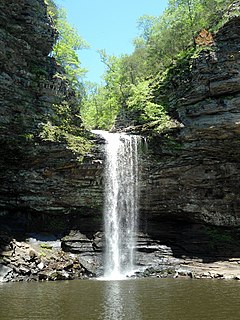
Petit Jean State Park is a 3,471-acre park in Conway County, Arkansas managed by the Arkansas Department of Parks and Tourism. It is located atop Petit Jean Mountain adjacent to the Arkansas River in the area between the Ouachita Mountains and Ozark Plateaus.
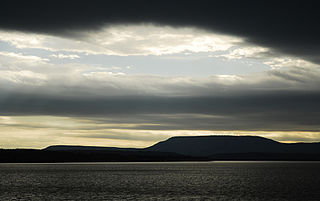
Located near Dardanelle, Arkansas and rising 1,350 feet (410 m) above the mountain valleys of west central Arkansas, Mount Nebo has a view of 34,000 acres (140 km2) Lake Dardanelle, the Arkansas River and the surrounding mountain ridges. Atop this biblically named plateau, fringed by the Ouachita National Forest, is Mount Nebo State Park. Developed as a resort area in the late 19th century, it became a state park in 1928, its early development spearheaded by the Civilian Conservation Corps. Park activities include hiking, camping, and other outdoor pursuits.

U.S. Route 64 is a U.S. highway running from Teec Nos Pos, Arizona east to Nags Head, North Carolina. In the U.S. state of Arkansas, the route runs 246.35 miles (396.46 km) from the Oklahoma border in Fort Smith east to the Tennessee border in Memphis. The route passes through several cities and towns, including Fort Smith, Clarksville, Russellville, Conway, Searcy, and West Memphis. US 64 runs parallel to Interstate 40 until Conway, when I-40 takes a more southerly route.

The Tall Pines Inn is a historic log cabin resort located at the junction of Pivot Rock Road and United States Route 62 in Eureka Springs, Arkansas. Established in 1947, it features six rustic cabins built from surrounding forests and modernized to meet the needs of today's traveler. Besides these cabins, which are of log construction, the inn has three suites which are part of the original log residence, twelve other cabins/suites with wood siding, and a swimming pool.

Bradley County Courthouse is a courthouse in Warren, Arkansas, United States, the county seat of Bradley County, built in 1903. It was listed on the National Register of Historic Places in 1976. The courthouse was built using two colors of brick and features a 2½ story clock tower.

The Champ Grubbs House is a historic antebellum dog trot log cabin in rural Drew County, Arkansas. It is located on Ozment Bluff Road, west of Arkansas Highway 172 and southwest of the county seat of Monticello. The single story log structure is estimated to have been built in 1859, and is one of the few such surviving buildings in the county. It was originally built to a typical dogtrot plan, although separate shed roof rooms were added to its rear in the 19th century, though these were removed and replaced with a similar addition in the 1980s. The center of the dog trot has been enclosed, and is accessed via a door from the front. The eastern log bay also functions as an entry, while that on the west side has been converted to a window. In much of the interior the log finish has been covered by paneling.
The SS Homer was a sidewheel paddle steamer which plied the waters of the Mississippi River and its tributaries. Built in 1859 in Parkersburg, West Virginia, she was 148 feet (45 m) long, 28 feet (8.5 m) wide, and 5 feet (1.5 m) deep. Her first significant service was in 1860, when she was used as a packet steamer on the Red and Ouachita Rivers, under master and co-owner Samuel Applegate. In 1861, after the start of the American Civil War, she was contracted to the government of the Confederate States of America, and was used to transport men and war materiel. She was used to supply the defenders of Port Hudson, Louisiana, in 1864. That year she was captured by the Union Army forces of General Frederick Steele when she was about 30 miles (48 km) below Camden, Arkansas on the Ouachita River. Steele was at the time engaged in a major expedition whose goal was to reach Shreveport, Louisiana, but had stalled due to Confederate resistance and a lack of supplies. Steele had then occupied Camden, and it was during this occupation that the ship was taken, loaded with grain and other supplies. The Union forces piloted her back to Camden.

The Ebenezer Campground is a historic Methodist summer camp meeting site in rural Howard County, Arkansas. Established in 1854, it is one of the oldest camp meeting sites in Arkansas. It is located in a forest clearing off Arkansas Highway 4 north of Center Point. It has six major structures: a tabernacle, three dormitories, and two minister's cabins. Although all of these structures were built in the 1940s or later, they were built using construction methods reminiscent of previous structures at the camp, and are roughly in the same locations. The tabernacle is a large open structure with a tin roof supported by square posts. The minister's cabins are modest one-room cabins finished with vertical pine boards. The dormitories are long rectangular structures subdivided into areas called "tents". Each "tent" consists of four rooms separated by a breezeway. Three of these rooms serve as bedrooms, while the fourth, which is open on two sides, serves as a dining area. Attached to each "tent" is a shed-roofed kitchen and cooking area. The dormitories have no windows, only openings cut into the horizontal clapboard siding to provide light and ventilation.

The Hillyard Cabin is a historic log cabin on Old Burr Road, northeast of Warm Springs, Arkansas. It is a single-pen log structure, with a gable roof and a fieldstone chimney. The pen is 14 feet (4.3 m) square, fashioned out of sawn logs laid without chinking. The east-facing front facade has a shed-roof porch extending across its width, with a doorway into the cabin on the right and a window on the left. The cabin was built in 1932-33 by a local resident for his brother, an Illinois resident, to use as a vacation site. The cabin is architecturally significant for its distinctive sawn-log construction style, in 1994, at which time it was undergoing restoration and rehabilitation.
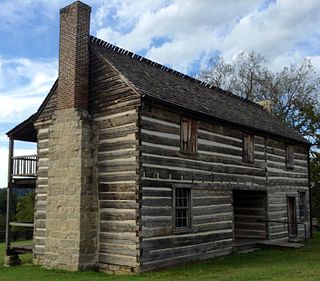
The Jacob Wolf House is a historic house on Arkansas Highway 5 in Norfork, Arkansas. It is a log structure, built in 1825 by Jacob Wolf, the first documented white settler of the area. Architecturally it's a "saddle bag", which is a two-story dog trot with the second floor built over the open breezeway. A two-story porch extends on one facade, with an outside stair giving access to the upper floor rooms. The building's original chinking has been replaced by modern mortaring. It is maintained by the Department of Arkansas Heritage as a historic house museum.

The Blackwell-Paisley Cabin is a historic summer cabin on Suits-Us Drive in Bella Vista, Arkansas. It is a 1-1/2 story wood frame structure, facing west, with a front gable roof. A carport is attached to the south facade of the main cabin, and projects forward of it, with its own gable roof. The rear of the carport is screened to provide a sitting area. Bedrooms on two levels are sheltered only by screens on three sides. The cabin was built in 1924 by Roy Cunningham, who built many summer retreat cabins in Bella Vista. This cabin is one of the few surviving and relatively unaltered cabins in the area from the period.

The Bogan Cabin is a historic summer cabin on a private spur road off Cedar Crest Drive, near Bella Vista, Arkansas. Built c. 1925, it is one of a small number of surviving cabins in this hill resort area. It is a single-story wood frame structure, with a gable roof that extends over a narrow open porch with a balustrade fashioned out of tree branches. A gabled wing extending to the east includes a covered carport and a porch, and a similar wing to the west shelters a deck. The cabin is surrounded on three sides by screened areas. The cabin represents a particularly creative use of outside spaces of the surviving cabins in the area.
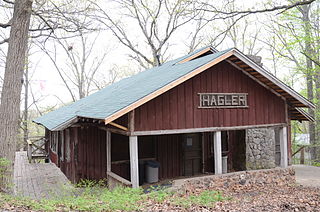
The Hagler-Cole Cabin is a historic summer cabin on Mt. Pisgah Loop in Bella Vista, Arkansas. It is a two-story wood frame structure with a wide overhanging front gable roof, which presents a single story to the front because of a steeply sloping lot. The front has a fieldstone chimney near the center, with a corner entry to the right, and a projecting gable-roofed screen porch to the left. Built c. 1920, it is one of a few relatively unaltered cabins in the Bella Vista area.

The Lamberton Cabin is a historic summer cabin at 8 North Mountain in Bella Vista, Arkansas. It is a roughly square single-story wood frame structure with a low-pitch gable roof. The roof is extended to the west by a shed-roofed sleeping porch, and there is an open deck to the east. The roof extends significantly beyond the walls, much of which consist of screened sections. The interior of the cabin, partitioned into living spaces, is further sheltered from the elements by the use of canvas shades. Built c. 1920, this is one a handful of period cabins to survive in Bella Vista, and one of its least-altered.

The Pharr Cabin is a historic summer cabin at 2 North Mountain in Bella Vista, Arkansas. It is a wood frame structure with a gable roof, presenting a single story to the front, and two to the rear on its steeply sloping lot. A porch extends across the front (south-facing) facade, with a lower-pitch gable roof. A large fieldstone chimney rises through both of these roofs. An open deck runs along the eastern facade. The sleeping areas on the lower level are enclosed only by screening. The cabin was built c. 1920, and is one of a small number of little-altered cabins built in that period in Bella Vista.

The Sutherlin Cabin is a historic summer cabin at 4 North Mountain in Bella Vista, Arkansas. Built c. 1924, it is the simplest of the handful of summer cabins in Bella Vista to survive from that period. It presents a single story at the front, but sits on a steeply sloping lot that provides a full second story at the rear. Unlike its contemporaries, it lacks projecting deck and porch sections, having only a narrow porch across its front, underneath the main hip roof. The cabin has bands of sash windows on all sides, interrupted only on the east side by the fieldstone chimney. The two levels of the cabin are not connected by an interior staircase.

The Lake Catherine State Park CCC Cabins are a collection of four rustic cabins constructed by crews of the Civilian Conservation Corps in what is now Lake Catherine State Park in Hot Spring County, Arkansas. Three of the four cabins were built for use as tourist accommodations and continue to serve in that role, while the fourth, probably built to house administrative functions, is now used in the state park as a "nature cabin", with exhibits on the history and natural environment of the park. Three of the cabins were separately listed on the National Register of Historic Places in 1992; the fourth was listed in 1995.
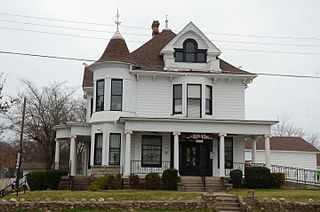
The Martone House is a historic house at 705 Malvern Avenue in Hot Springs, Arkansas. It is a 2 1⁄2-story wood-frame structure, with a hip roof, clapboard siding, and a stone foundation. It has Queen Anne Victorian styling, with a gabled projecting window bay, rounded turret projecting at one corner, and a wraparound porch. It was built in 1907 for Thomas and Nina (Cascoldt) Doherty, and is notable as one of Hot Springs' first motel properties, as it was where the Dohertys not only let rooms in the house, but also built cabins to the rear of the property to house more visitors.

Mayberry Springs is a historic traveler's accommodation and early resort on United States Route 270 near Crystal Springs, Arkansas. Located roughly midway between Hot Springs and Mount Ida, the main surviving structure is a single-story wood frame structure with vernacular Greek Revival styling. A shed-roof porch extends across its front, ending in an enclosed room at one end. The building was probably built about 1895, but the site has a documented history as a stagecoach stop and bathhouse at least as far back as 1850. Historic archaeological remains at the site include cabin foundations and multiple wellheads.

The Lake Catherine State Park-Bridge No. 2 is a historic bridge, carrying Arkansas Highway 171 across an unnamed stream in the western part of Lake Catherine State Park in Hot Spring County, Arkansas. The bridge is a rustic stone structure, with stone abutments rising to low piers just above the roadway at its four corners. Built in 1935 by crews of the Civilian Conservation Corps, it is one of a number of surviving CCC-built structures in the park.

















